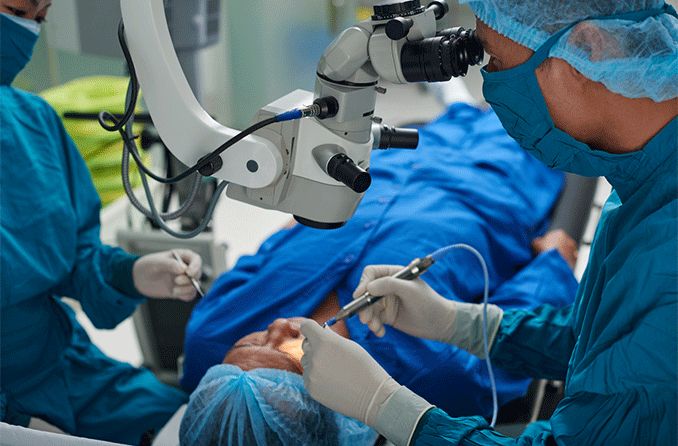What is refractive cataract surgery?
- What is refractive cataract surgery?
- How is refractive cataract surgery different from standard cataract surgery?
- How does refractive cataract surgery achieve glasses-free clear vision?
- Am I a good candidate for refractive cataract surgery?
- How do I make an informed decision about refractive cataract surgery?

What is refractive cataract surgery?
Refractive cataract surgery replaces a cloudy natural lens with an artificial lens. The artificial lens is called a refractive intraocular lens (IOL). Refractive IOLs can correct nearsightedness, farsightedness, astigmatism or presbyopia, allowing clear vision without glasses.
How is refractive cataract surgery different from standard cataract surgery?
Both surgeries replace the clouded natural lens with a clear IOL, and both are safe and effective.
After standard cataract surgery, a patient may still need glasses. This is because standard IOLs cannot always correct more complex refractive errors.
After refractive cataract surgery, a patient should not need glasses for distance vision. Some patients are also glasses-free for near vision. Before the procedure, the surgeon will determine if a patient is a good candidate. Then, the surgeon will select the proper IOL to correct the patient’s refractive errors.
How does refractive cataract surgery achieve glasses-free clear vision?
Standard cataract surgery uses a simpler, monofocal design IOL
The IOL used in standard cataract surgery cannot always correct refractive errors completely. After surgery, there may be moderate amounts of myopia, hyperopia and astigmatism remaining. Even moderate refractive errors require the use of glasses to correct vision. Many patients also still need reading glasses after surgery. This is because the IOL used in standard cataract surgery is usually focused for distance.
Refractive cataract surgery uses a premium design IOL
People with astigmatism often have prescriptions that standard IOLs cannot fully correct. They need a premium “toric” IOL to correct their astigmatism.
Some people with presbyopia wish to stop wearing reading glasses after cataract surgery. “Accommodating” and “multifocal” IOLs allow focus at distance, intermediate and near. These IOLs can end the need for reading glasses.
Refractive cataract surgery is able to:
Replace the patient’s clouded natural lens with a clear, artificial IOL.
Correct a patient’s refractive error with a specialized refractive IOL.
Correct presbyopia with an accommodating or multifocal IOL.
The healing process after refractive cataract surgery varies for each patient. Once the eyes have stabilized, the surgeon can make adjustments to achieve 20/20 vision if needed.
Am I a good candidate for refractive cataract surgery?
The answer depends on your lifestyle, vision needs and financial goals.
Refractive surgery may be a good option for you if:
Your goal is to be glasses-free after cataract surgery
It is often difficult to fully correct refractive error with standard cataract surgery. Refractive cataract surgery enables patients to end their dependence on glasses or contacts.
Your prescription includes astigmatism
You may need a premium toric IOL to correct your refractive error.
You want be free of reading glasses
A premium multifocal or accommodating IOL can provide clear vision at distance and near.
You are able to make the financial commitment
Refractive cataract surgery costs more than standard cataract surgery. Insurance usually covers standard cataract surgery. The extra cost of refractive cataract surgery is usually paid by the patient.
How do I make an informed decision about refractive cataract surgery?
If you have been told that you need cataract surgery, ask your doctor if you are a candidate for refractive cataract surgery. After an evaluation, your doctor will discuss your options with you. These options may depend on your lifestyle, vision goals and finances. Your doctor will help you make an informed choice based on these considerations.
The evolution of cataract surgery. Missouri Medicine. Jan-Feb 2016.
Refractive outcome of cataract surgery done at University of Gondar Tertiary Eye Care and Training Center, North West Ethiopia. Patient Related Outcome Measures. June 2021.
Consensus on the management of astigmatism in cataract surgery. Clinical Ophthalmology. June 2018.
Emerging technology in refractive cataract surgery. Journal of Ophthalmology. June 2016.
Page published on Wednesday, August 18, 2021




